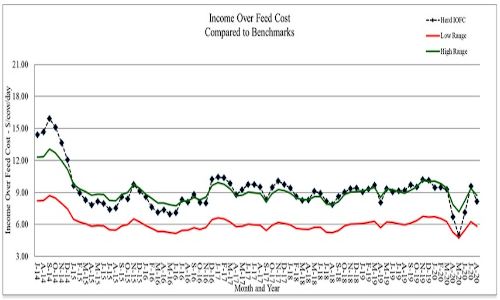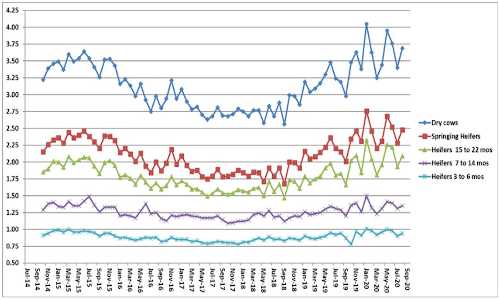Production perspective:
Heat stress can impact animal performance weeks beyond the initial occurrence. Lactating cows are usually the focus of heat abatement strategies; however, the dry cows and springing heifers can also be negatively impacted by heat stress. This can linger on into the fresh cow period and ultimately affect overall production. There are several key performance indicators that can be used to determine if transition cow problems are occurring and how severely they are affecting milk volume and components.
For dairy operations that utilize the Dairy Herd Improvement Association (DHIA), there are reports that provide a wealth of information. The DHI-202 Summary Report contains data that can help determine if transition cow problems are an issue. The “Stage of Lactation Profile” table contains production and component data based on days in milk and lactation group. This can be the initial drill down for herds not meeting the benchmarks for milk volume and components. In today’s market, herds milking 2x should average greater than 75 pounds on an annual basis and 3x milking herds greater than 85 pounds. Pounds of components should exceed 5.5 at a minimum.
If a herd is not meeting production and component benchmarks the following metrics are useful in determining if the problem is stemming from the transition period. This approach may not be appropriate for small sized herds as the number of animals in the first 40-day category may be small. Results may reflect individuals versus a group. If ample animal numbers are represented, the following would be a high concern level that a problem may exist:
| Test day milk in the first 40 days in milk, all lactations | < 80 pounds |
| Ratio of second test day milk to first test day milk, all lactations | <1.10 or >1.15 |
| Fat percent in the first 40 days in milk, all lactations | <3.4% or >4.6% |
| Fat to protein ratio in the first 40 days in milk, all lactations | <1.35 |
| Test day milk first 40 days in milk, first lactation animals | <60 pounds |
If at least three out of the five metrics are a concern, then evaluating the dry period and post fresh group would be recommended. Facilities, feeding management, nutrition, grouping strategies, and the heifer raising program would be the main areas to investigate. Monitoring dry matter intake for the period prior to and after freshening would help determine if nutrient adjustments are warranted. Monitoring body condition score and calculating weight loss during the transition period can define possible feeding strategies to correct performance problems. Another metric that may help drill down to energy balance is checking the protein percent in the 41 to 100 days in milk range. If any lactation group has less than 2.7 percent protein, this may indicate negative energy balance.
Forage quality could be a potential culprit to transition cow problems, especially this year. Due to the extreme summer heat and spotty rainfall, hay crop forage and corn silage quality may be inconsistent. Fiber digestibility and starch content and digestibility may be compromised and affect the energy content of the diet. Poor silage fermentation due to inconsistent or less than ideal dry matter at harvest might prove problematic. It is better to catch problems early and adjust, especially with so many unknowns in the dairy industry with milk price, the pandemic, and the impact on milk income.
Economic perspective:
Monitoring must include an economic component to determine if a management strategy is working or not. For the lactating cows, income over feed cost is a good way to check that feed costs are in line for the level of milk production. Starting with July 2014’s milk price, income over feed cost was calculated using average intake and production for the last six years from the Penn State dairy herd. The ration contained 63% forage consisting of corn silage, haylage and hay. The concentrate portion included corn grain, candy meal, sugar, canola meal, roasted soybeans, Optigen and a mineral vitamin mix. All market prices were used.
Also included are the feed costs for dry cows, springing heifers, pregnant heifers and growing heifers. The rations reflect what has been fed to these animal groups at the Penn State dairy herd. All market prices were used.
Income over feed cost using standardized rations and production data from the Penn State dairy herd.

August’s Penn State milk price: $18.39/cwt; feed cost/cow: $6.37; average milk production: 79 lbs.
Feed cost/non-lactating animal/day.

Source : psu.edu